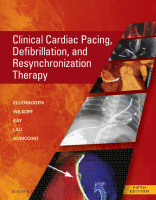Physical Address
304 North Cardinal St.
Dorchester Center, MA 02124

Anatomy The sinus (or sinoatrial, SA) node lies near the junction of the superior vena cava and the right atrium. The sinus node is supplied by the sinus nodal artery, which originates from the proximal few centimeters of the right…

Sinus node disease (SND) is the most common indication for a cardiac pacing system. SND increases exponentially with age and occurs in 1 of every 600 cardiac patients older than 65 years. In an analysis of a community-based general population…

Introduction The implantation of permanent pacemakers (PPMs) and implantable cardioverter-defibrillators (ICDs) for the treatment of bradyarrhythmia and tachyarrhythmia has increased significantly over the past 30 years. In a review of the National Inpatient Sample, researchers found that 2.9 million PPMs…

Leads connect the pulse generator of a cardiac implantable electronic device (CIED) to sites within the body to form an electric circuit ( Fig. 11-1 ). Leads contain five categories of basic components (electrodes, conductors, insulation materials, fixation mechanisms, and…

Implantable sensors monitor changes in the body's physiologic conditions. Detection of physiologic changes may be used to modulate the pacing rate of a rate-adaptive pacing system so that the pacing rate is optimized to meet the requirements during exercise and…

Cardiac implantable electronic devices (CIEDs), first used in 1958, have become highly sophisticated therapeutic tools for the management of bradyarrhythmias, tachyarrhythmias, and more recently, cardiac resynchronization therapy. The implanted system comprises cardiac leads connected to a generator containing a power…

Introduction This chapter is about batteries and capacitors used to power pacemakers, defibrillators, and other similar implantable devices. Batteries are active components that convert chemical energy into electrical energy, whereas capacitors are passive and temporarily store energy, often to increase…

Cardiac pacing significantly improves the survival and quality of life in patients with bradycardia and/or dyssynchrony. When first introduced, pacemakers were simply lifesaving devices that provided a fixed pacing rate during bradycardia. With advances in technology and in our understanding…

Introduction The burden of tachyarrhythmias has been well described, both in the United States and around the world. Sudden cardiac death is responsible for an estimated 184,000 to 400,000 deaths annually in the United States alone. Of these, the majority…

Introduction Rapid advances in the field of detection and modulation of electrical signals within the nervous system have led to the development of a new class of pacing strategies to modulate the nervous system regulating the heart and beyond. Notably,…